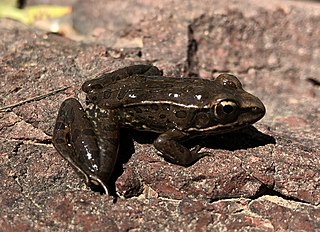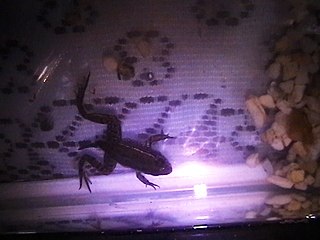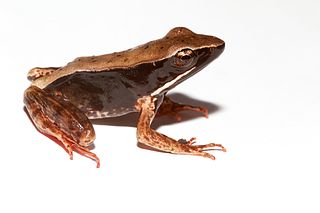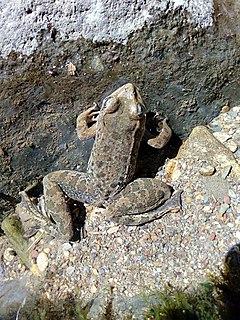Aromobates meridensis is a species of frog in the family Aromobatidae. It is endemic to the Cordillera de Mérida near Chorotal, Venezuela.
The Rio Chipillico frog is a species of frog in the family Ranidae, found in Ecuador and Peru. Its natural habitats are tropical forests near fast-flowing rivers; it breeds in pools of water near rivers. It is threatened by habitat loss caused by agricultural expansion and human settlement.
The Lago de las Minas frog is a species of frog in the family Ranidae. It is endemic to the Las Minas Lake in the Oriental Basin of Puebla, Mexico. Its natural habitat is vegetation surrounding the lake. It is threatened by deterioration in the quality of habitat surrounding the lake as well as the decline in lake surface level caused by groundwater extraction.
The Maya Mountains frog is a species of frog in the family Ranidae found in Belize and possibly Guatemala. Its natural habitats are subtropical or tropical moist lowland forests, moist savanna, and rivers. This anuran is found primarily in the Mayan Mountain region between 100m and 915m of elevation.
The Guatemala plateau frog is a species of frog in the family Ranidae. It occurs in Guatemala and southern Mexico. It is impossible to morphologically distinguish this species from Lithobates forreri and Lithobates brownorum, and the validity of it has been questioned. It is an uncommon frog that inhabits cloud forests, including degraded forest, and grassland. Breeding takes place in streams and small temporary ponds. It is threatened by habitat degradation caused by agricultural encroachment, wood extraction, human settlement, and water pollution.

The highland frog, also known as the masked mountain frog, is a species of frog in the family Ranidae, known from El Salvador, Guatemala, Honduras, Mexico, and Nicaragua. Its natural habitats are subtropical or tropical moist lowland forests, subtropical or tropical moist montane forests, rivers, and freshwater marshes. It is threatened by habitat loss.
The big-footed leopard frog or bigfoot leopard frog, is a species of frog in the family Ranidae endemic to western central Mexico where it is found in the Nayarit, Jalisco, Michoacan, and Guanajuato states.
The island leopard frog or Little Corn Island frog is a species of frogs in the family Ranidae, endemic to Little Corn Island off the Caribbean coast of Nicaragua. It is locally known as rana leopardo isleña.

The Montezuma leopard frog, Lithobates montezumae, is a species of frog in the family Ranidae endemic to Mexico. Its natural habitats are pine-oak or oak forests above 2,000 m (6,600 ft) asl but it can also survive in moderately altered habitats. It breeds in lakes and big pools. It is potentially threatened by habitat loss and introduced predators. It is also collected for human consumption.

The transverse volcanic leopard frog is a species of frog in the family Ranidae endemic to the southern edge of the Mexican Plateau, Mexico. Its natural habitats are pine-oak forests and mesquite grasslands near lakes, pools or slow-flowing streams. It is threatened by habitat loss.

The relict leopard frog is a species of frog in the family Ranidae, endemic to the United States. It is found along the Colorado river in extreme northwestern Arizona, and adjacent Nevada and southwestern Utah, although its present range seems to be restricted to the Lake Mead National Recreation Area. Its natural habitat is freshwater springs and their outlets. It is threatened by habitat loss to agriculture and water development as well as invasive species.
The smooth-backed frog is a species of frog in the family Ranidae endemic to Mexico.
The Puebla frog or Pueblan pool frog, Lithobates pueblae, is a species of frog in the family Ranidae endemic to Necaxa River near Huauchinango, Puebla state, Mexico, where it is known as rana poblana. It was thought to probably be extinct until 2010 when Dr. Georg Hantke from the National Museum of Scotland re-discovered it.
The Sierra Madre frog is a species of frog in the family Ranidae endemic to the Sierra Madre del Sur in Guerrero and Oaxaca states, Mexico. Its local name is rana de Sierra Madre Occidental. Its natural habitats are conifer forests at intermediate elevations. Breeding takes place in streams. It is threatened by habitat loss (logging) and possibly chytridiomycosis.

The Peralta frog, or montane leopard frog, Lithobates taylori, is a species of frog in the family Ranidae found in Costa Rica and Nicaragua.

Tlaloc's leopard frog, or rana de Tláloc in Spanish, is a species of frog in the family Ranidae endemic to the Valley of Mexico. It is most likely extinct.

Vaillant's frog is a species of frog in the family Ranidae found in Central America. Its natural habitats are subtropical or tropical dry forests, subtropical or tropical moist lowland forests, subtropical or tropical swamps, rivers, swamps, freshwater lakes, intermittent freshwater lakes, freshwater marshes, intermittent freshwater marshes, rural gardens, heavily degraded former forests, water storage areas, ponds, and canals and ditches.
Lithobates vibicarius, commonly known as either green-eyed frog or Rancho Redondo frog, is a species of frog in the family Ranidae from highland rainforests in Costa Rica and western Panama.

Warszewitsch's frog is a species of frog in the family Ranidae found in Honduras, Nicaragua, Costa Rica, and Panama.

Zweifel's frog is an amphibian species endemic to Mexico. It is a member of the true frog family, Ranidae.









